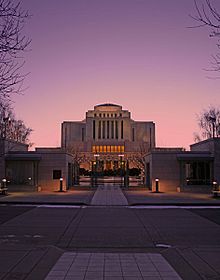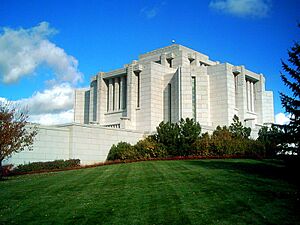Cardston Alberta Temple facts for kids
| Cardston Alberta Temple | |||||||||||||||||||||||||||||||||||||||||||||||
|---|---|---|---|---|---|---|---|---|---|---|---|---|---|---|---|---|---|---|---|---|---|---|---|---|---|---|---|---|---|---|---|---|---|---|---|---|---|---|---|---|---|---|---|---|---|---|---|
 |
|||||||||||||||||||||||||||||||||||||||||||||||
| Number | 6 | ||||||||||||||||||||||||||||||||||||||||||||||
| Dedicated | Quick facts for kids 26 August 1923 byHeber J. Grant |
||||||||||||||||||||||||||||||||||||||||||||||
| Site | 10 acres (4 hectares) | ||||||||||||||||||||||||||||||||||||||||||||||
| Floor area | 81,700 sq ft (7,590 m2) | ||||||||||||||||||||||||||||||||||||||||||||||
| Height | 85 ft (26 m) | ||||||||||||||||||||||||||||||||||||||||||||||
| Preceded by | Laie Hawaii Temple | ||||||||||||||||||||||||||||||||||||||||||||||
| Followed by | Mesa Arizona Temple | ||||||||||||||||||||||||||||||||||||||||||||||
| Official website: https://www.churchofjesuschrist.org/temples/details/cardston-alberta-temple • News & images | |||||||||||||||||||||||||||||||||||||||||||||||
|
|||||||||||||||||||||||||||||||||||||||||||||||
| Cardston Alberta Temple | |
|---|---|
| Location | Cardston, Southern Alberta, Alberta, Canada |
| Area | 10 acres (40,000 m2) |
| Founded | June 27, 1913 |
| Built | 1913–1923 |
| Architectural style(s) | LDS temple |
| Governing body | The Church of Jesus Christ of Latter-day Saints |
| Website | Official LDS Cardston Alberta Temple page: https://www.churchofjesuschrist.org/temples/main/0,11204,1912-1-42-0,00.html |
| Designated | 1992 |
The Cardston Alberta Temple is a special building for the Church of Jesus Christ of Latter-day Saints. It's located in Cardston, Alberta, Canada. This temple was the eighth one built by the Church and is still in use today.
The plan to build this temple was announced on October 12, 1912. This happened during a big meeting called general conference. It was the very first temple built in Canada and also the first one built outside the United States. Today, there are four temples in Alberta and ten across Canada.
The Cardston Alberta Temple has a unique cross shape. It's one of only two temples built in this style. It also doesn't have tall spires, which makes it stand out. The temple was designed by Harold W. Burton and Hyrum Pope. They were inspired by American architect Frank Lloyd Wright. Their design used cool geometric shapes and blended with the nature around it. Construction officially began on November 9, 1913.
Contents
Building the Temple: A Look Back
The idea to build the temple was shared by Church President Joseph F. Smith in 1912. It was built on a piece of land called Tabernacle Block. This land, about eight acres, was given to the Church by Charles Ora Card.
Starting Construction
A special ceremony, called a groundbreaking, happened on November 9, 1913. This event marked the start of building the temple. President Smith led the ceremony, and many local Church members and community leaders attended.
Building the temple took a long time, about 10 years. There were some challenges, like delays because of World War I. The last two years were spent getting the inside ready for use.
During construction, a group called the Relief Society started a "penny subscription." They saved a penny each week. This effort helped them donate over $13,000 to build both the Cardston Alberta Temple and the Laie Hawaii Temple.
Temple Dedication and Changes
The temple was officially dedicated on August 26, 1923. Church President Heber J. Grant led this important event. In the mid-1950s, the temple grounds grew to more than 10 acres.
An addition to the temple was dedicated on July 2, 1962. Hugh B. Brown led this dedication. The first person in charge of the temple, called a temple president, was Edward J. Wood. He served for 25 years, from 1923 to 1948.
The temple was updated in the 1990s. After these updates, Gordon B. Hinckley rededicated it on June 22, 1991.
A National Historic Site
In 1992, the Cardston Alberta Temple was named a National Historic Site by Parks Canada. There's a special plaque at the temple to show this important recognition. The temple is also on the Church's list of Historic Landmarks.
In 2010, the temple received the "Cardston Beautiful Annual Beautification Award." This award is given for making the city more beautiful. The mayor at the time, Stan Johnson, said the temple made a "tremendous contribution" to the community's beauty.
Like other temples, the Cardston Alberta Temple was temporarily closed in 2020. This was in response to the COVID-19 pandemic.
Temple Design and Look
The Cardston Alberta Temple has a unique architectural style. It mixes ideas from ancient Greek designs with some influences that look like Aztec temples. It also blends with traditional temple designs of the Church.
The temple's design shows both the history of Cardston town and the spiritual meaning for the Church. It was inspired by architect Frank Lloyd Wright and combines Mayan-Aztec and Prairie School styles. At the time it was built, it was special because it didn't need a large meeting hall inside. A newspaper, the Deseret Evening News, said its inside would be like other temples, but its "outside it is totally unlike any of them."
The temple has four special rooms for ceremonies and five rooms for family sealing ceremonies. It has a total floor area of 88,562 square feet. The building is made of white granite. This stone came from a quarry near Kootenai Lakes in Nelson, British Columbia.
The outside of the temple has a single central tower with a pyramid-shaped roof. It features hand-shaped stone and beautiful stained-glass windows. Inside, you'll find woods and materials from all over the world. There are also hand-painted murals and a sculpted water feature.
The temple is a main feature of the town's central square. It's surrounded by a stone wall and offers views of Chief Mountain. Its eight-sided shape under a pyramid roof and its cross layout are special features. These features point to its historical importance.
The design uses symbols from the Bible. These symbols give deeper spiritual meaning to the temple's look and purpose. The temple sits on a small hill surrounded by prairies. The grounds have large trees, flower gardens, and paved walkways.
Temple Updates and Care
The temple has been updated twice to keep it strong and beautiful. These updates also helped make sure it met modern building rules. The biggest update started in 1988.
These updates made sure the temple was safe and worked well. They also helped it meet the needs of the Church and its members today.
Some of the updates included new electrical and mechanical systems. An entryway was added to the front of the building, and the inside was refreshed. These improvements were made while keeping the temple's original design and decorations. Great care was taken to protect the temple's history during the updates. The renovated temple was rededicated on June 22, 1991, by Gordon B. Hinckley.
Community Connection
In 1887, Charles Ora Card and other Church members came to this area. They started a settlement at Lee Creek, Alberta, which is now Cardston. A building called a tabernacle was built to support the growing Church community. Cardston was chosen as the place to build the temple in Canada. Since the Church already owned the land where the tabernacle stood, it was taken down to make way for the temple.
The temple has had a big impact on the culture and community of Cardston. Since it was built in 1913, it has been a place of worship for Church members. It also represents the history of the pioneers who settled the area. At the time, the temple showed that the Church was growing beyond the United States.
The temple and its beautiful grounds are often a place for community events. These include open houses, weddings, and Church activities. People also come to worship God and perform sacred ceremonies. These events help bring the community together and help people from different backgrounds understand each other.
The Canadian government officially named the temple a Historic Site on September 16, 1995.
Temple Leaders
Since it was dedicated in 1923, the temple has had many leaders. These leaders are called temple presidents and matrons. They usually serve for three to five years. The first president, Edward James Wood, served for 25 years. The temple president is in charge of running the temple and guiding those who visit and work there.
Edward James Wood was the first temple president, serving from 1923 to 1948. Under his leadership, the temple became a key place for spiritual activities and community involvement in Cardston. As of 2022, Forast Brent Thomas is serving as the temple president. Other notable leaders include Merlin R. Lybbert (1994–97), Elaine L. Jack (1997–2000), and Ardeth G. Kapp (2000–03).
Visiting the Temple
The temple is a central place for worship and spiritual ceremonies for members of the Church. To enter the temple, members need a special pass called a temple recommend.
Inside the temple, members perform important ceremonies. These include baptisms for the dead (acting for those who have passed away), endowment ceremonies, and sealings. These ceremonies are very important to the Church's beliefs.
Before the temple was dedicated, it was open to the public for an "open house." This allowed people of all faiths to see the temple's design and learn about the Church's practices and beliefs.
The temple was dedicated on July 27, 1913, by Joseph F. Smith. An addition was dedicated on July 2, 1962, by Hugh B. Brown. After its renovations, it was rededicated on June 22, 1991, by Gordon B. Hinckley.
Gallery
See also
 In Spanish: Templo de Alberta para niños
In Spanish: Templo de Alberta para niños
|
Temples in Alberta () Canada Temples
Temples in Canada ()
|
- Comparison of temples of The Church of Jesus Christ of Latter-day Saints
- Torleif S. Knaphus — sculpted the large Christ the Fountainhead on the exterior of the building and also the life-size oxen holding the baptism font
- LeConte Stewart - painted murals and other art work in the temple
- List of National Historic Sites of Canada in Alberta
- List of temples of The Church of Jesus Christ of Latter-day Saints
- List of temples of The Church of Jesus Christ of Latter-day Saints by geographic region
- Temple architecture (Latter-day Saints)
- The Church of Jesus Christ of Latter-day Saints in Canada







